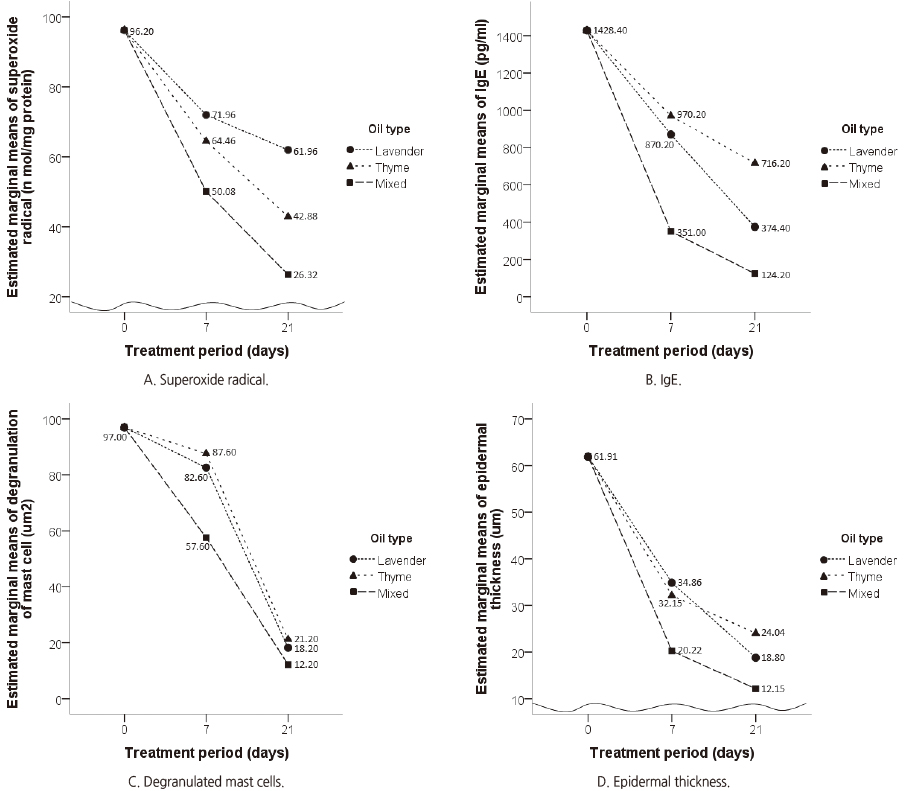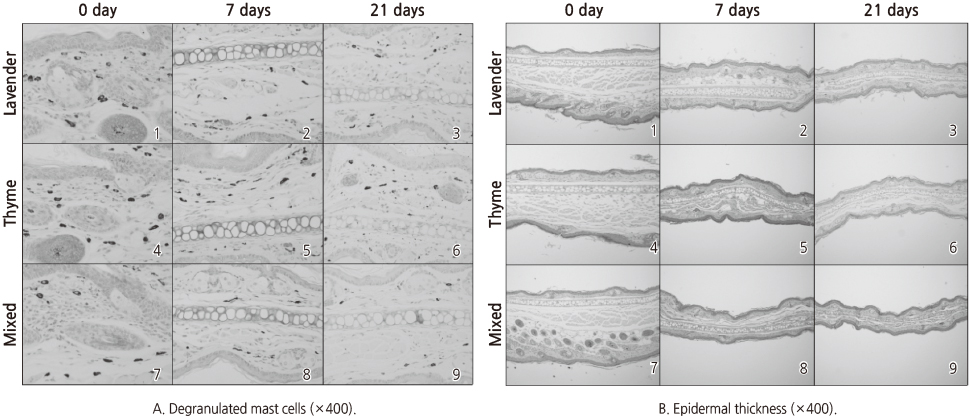J Korean Acad Nurs.
2015 Jun;45(3):367-377. 10.4040/jkan.2015.45.3.367.
Effects of Blending Oil of Lavender and Thyme on Oxidative Stress, Immunity, and Skin Condition in Atopic Dermatitis Induced Mice
- Affiliations
-
- 1Department of Nursing, Jeonju University, Jeonju, Korea.
- 2College of Nursing, Chonbuk National University, Jeonju, Korea. awesomeprof@jbnu.ac.kr
- 3Research Institute of Nursing Science, Chonbuk National University, Jeonju, Korea.
- KMID: 2164378
- DOI: http://doi.org/10.4040/jkan.2015.45.3.367
Abstract
- PURPOSE
The purpose of this study was to evaluate the effects of essential oil on oxidative stress, immunity, and skin condition in atopic dermatitis (AD) induced mice.
METHODS
This study was a 3x3 factorial design. Factors were oil type (Lavender, Thyme, and 2:1 mixture of lavender and thyme oil [blending oil]) and treatment period (0 day, 7 days, and 21 days). The samples were 45 mice with AD and randomly assigned to nine groups of five mice per group. The dependent variables such as superoxide radical, IgE, degranulated mast cells, and epidermal thickness were measured. Data were collected from February to April in 2014. Descriptive statistics, One-way ANOVA, Two-way ANOVA, and Tukey's HSD test were performed using the SPSS WIN 20.0 program.
RESULTS
Dependent variables were not statistically significantly different by the three oil types (p >.05). Essential oils such as lavender, thyme, and blending oil were all effective in reducing AD symptoms and especially 2:1 blending oil were most effective. There were statistically significant differences by the three treatment periods in all dependent variables (p <.001). There were statistically significant interactions between oil types and treatment periods in all dependent variables (p <.01). For decreasing superoxide radical, degranulated mast cells, and epidermal thickness, 2:1 mixed oil should be applied for at least 21 days. Otherwise to reduce IgE, 2:1 mixed oil should be used for at least 7 days.
CONCLUSION
These findings provide bases for developing effective interventions for AD patients to manage their AD symptoms.
Keyword
MeSH Terms
-
Animals
Dermatitis, Atopic/chemically induced/*drug therapy/pathology
Disease Models, Animal
*Immunity/drug effects
Immunoglobulin E/blood
Lavandula/*chemistry/metabolism
Mast Cells/cytology/metabolism
Mice
Oils, Volatile/chemistry/pharmacology/therapeutic use
*Oxidative Stress/drug effects
Picryl Chloride/toxicity
Plant Oils/chemistry/pharmacology/*therapeutic use
Singlet Oxygen/metabolism
Skin/drug effects/pathology
Thymus Plant/*chemistry/metabolism
Immunoglobulin E
Oils, Volatile
Picryl Chloride
Plant Oils
Singlet Oxygen
Figure
Reference
-
1. Deckers IA, McLean S, Linssen S, Mommers M, van Schayck CP, Sheikh A. Investigating international time trends in the incidence and prevalence of atopic eczema 1990-2010: A systematic review of epidemiological studies. PLoS One. 2012; 7(7):e39803. DOI: 10.1371/journal.pone.0039803.2. Elias PM, Schmuth M. Abnormal skin barrier in the etiopathogenesis of atopic dermatitis. Curr Allergy Asthma Rep. 2009; 9(4):265–272.3. Oak JW, Lee HS. Prevalence rate and factors associated with atopic dermatitis among Korean middle school students. J Korean Acad Nurs. 2012; 42(7):992–1000. DOI: 10.4040/jkan.2012.42.7.992.4. Statistics Korea. Prevalence trends of atopic dermatitis 2007-2010 [Internet]. Daejeon: Author;2013. cited 2013 September 30. Available from: http://kosis.kr/genetl/start.jsp?orgId=117&tblId=DT_11702_N114&conn_path=I3&path.5. Park CW. Atopic dermatitis and allergy. J Skin Barrier Res. 2012; 14(2):38–41.6. Jiang MZ, Tsukahara H, Ohshima Y, Todoroki Y, Hiraoka M, Maeda M, et al. Effects of antioxidants and nitric oxide on TNF-alpha-induced adhesion molecule expression and NF-kappaB activation in human dermal microvascular endothelial cells. Life Sci. 2004; 75(10):1159–1170. DOI: 10.1016/j.lfs.2004.01.031.7. Leung DY, Boguniewicz M, Howell MD, Nomura I, Hamid QA. New insights into atopic dermatitis. J Clin Invest. 2004; 113(5):651–657. DOI: 10.1172/jci21060.8. Peroni DG, Bodini A, Corradi M, Coghi A, Boner AL, Piacentini GL. Markers of oxidative stress are increased in exhaled breath condensates of children with atopic dermatitis. Br J Dermatol. 2012; 166(4):839–843. DOI: 10.1111/j.1365-2133.2011.10771.x.9. Yamashita H, Tasaki D, Makino T, Matsuoka K, Nose M, Inagaki N, et al. The role of IgE and repeated challenge in the induction of persistent increases in scratching behavior in a mouse model of allergic dermatitis. Eur J Pharmacol. 2009; 605(1-3):153–157. DOI: 10.1016/j.ejphar.2009.01.006.10. Cowden JM, Zhang M, Dunford PJ, Thurmond RL. The histamine H4 receptor mediates inflammation and pruritus in Th2-dependent dermal inflammation. J Invest Dermatol. 2010; 130(4):1023–1033. DOI: 10.1038/jid.2009.358.11. Kim JH, Kim H, Park CW, Lee CH. Quality of life in adults with atopic dermatitis. Korean J Dermatol. 2011; 49(11):983–992.12. Kim KH, Park AY, Kim JS. Factors associated with atopic dermatitis in Korean adults: The Korean national health and nutrition survey 2008. Korean J Rehabil Nurs. 2012; 15(2):83–90.13. Kleiman A, Tuckermann JP. Glucocorticoid receptor action in beneficial and side effects of steroid therapy: Lessons from conditional knockout mice. Mol Cell Endocrinol. 2007; 275(1-2):98–108. DOI: 10.1016/j.mce.2007.05.009.14. Kim S. The actual condition for the use of aroma therapy on children's atopic dermatitis [master's thesis]. Gwangju: Chosun University;2007.15. Buckle J. Clinical aromatherapy: Essential oils in practice. 2nd ed. Philadelphia, PA: Churchill Livingstone;2003.16. Han SH, Seo YM. The effect of essential oil on atopic dermatitis model of NC/Nga mice. J Korean Biol Nurs Sci. 2014; 16(3):219–225. DOI: 10.7586/jkbns.2014.16.3.219.17. Seo YM. Recovery effect of blending oil on skin barrier damaged by atopic dermatitis. J East West Nurs Res. 2014; 20(1):57–62. DOI: 10.14370/jewnr.2014.20.1.57.18. Lee GH, Yun MY, Cheong KJ. How aroma oil affects animal model with atopic dermatitis by DNCB on anti-inflammatory. J Korean Soc Cosmetol. 2012; 18(1):144–151.19. Sin GR, Kim YW. Effect of mixed oil composed of chamomile German, lavender, and sandalwood on skin lesion immune-related factors in atopic dermatitis of animal model (NC/Nga). In : Proceedings of the Korean Society for Emotion and Sensibility Conference; 2009 May 22-23; Daejeon: Korea Research Institute of Standards and Science. Korean Living Science Association;2009. p. 201–204.20. Jee CH, Kang MG. Repellent effect of camomile and lavender essential oils against house dust mite in bed fabric. J Biomed Res. 2012; 13(1):21–26. DOI: 10.12729/jbr.2012.13.1.21.21. Park ST, Kim JW, Jeong SH, Seo YM. The effect of extract from several herbs grown naturally in Namwon province on wound treatment. J Korean Biol Nurs Sci. 2012; 14(2):122–128. DOI: 10.7586/jkbns.2012.14.2.122.22. Guo N, Liu J, Wu X, Bi X, Meng R, Wang X, et al. Antifungal activity of thymol against clinical isolates of fluconazole-sensitive and-resistant Candida albicans. J Med Microbiol. 2009; 58(Pt 8):1074–1079. DOI: 10.1099/jmm.0.008052-0.23. Youdim KA, Deans SG. Effect of thyme oil and thymol dietary supplementation on the antioxidant status and fatty acid composition of the ageing rat brain. Br J Nutr. 2000; 83(1):87–93.24. Sies H. What is oxidative stress?. In : Keaney JF, editor. Oxidative stress and vascular disease. New York, NY: Springer;2000. p. 1–8.25. Chi JG, editor. Medical dictionary: English-Korean, Korean-English. 2nd ed. Anyang: Academya;2009.26. Festing MF, Baumans V, Combes RD, Halder M, Hendriksen CFM, Howard BR, et al. Reducing the use of laboratory animals in biomedical research: Problems and possible solutions. Altern Lab Anim. 1998; 26(3):283–301.27. Ozcan M. Antioxidant activities of rosemary, sage, and sumac extracts and their combinations on stability of natural peanut oil. J Med Food. 2003; 6(3):267–270. DOI: 10.1089/10966200360716698.28. Atsumi T, Tonosaki K. Smelling lavender and rosemary increases free radical scavenging activity and decreases cortisol level in saliva. Psychiatry Res. 2007; 150(1):89–96. DOI: 10.1016/j.psychres.2005.12.012.29. Lundberg L, Johannesson M, Silverdahl M, Hermansson C, Lindberg M. Health-related quality of life in patients with psoriasis and atopic dermatitis measured with SF-36, DLQI and a subjective measure of disease activity. Acta Derm Venereol. 2000; 80(6):430–434.30. Altiok D, Altiok E, Tihminlioglu F. Physical, antibacterial and antioxidant properties of chitosan films incorporated with thyme oil for potential wound healing applications. J Mater Sci Mater Med. 2010; 21(7):2227–2236. DOI: 10.1007/s10856-010-4065-x.
- Full Text Links
- Actions
-
Cited
- CITED
-
- Close
- Share
- Similar articles
-
- Effects of Back Massage with Lavender Essence Oil on the Stress Response of the ICU Nurses
- Differences in Neurotransmitters Level as Biomarker on Sleep Effects in Dementia Patients with Insomnia after Essential Oils Treatment
- Effect of German chamomile oil application on alleviating atopic dermatitis-like immune alterations in mice
- UVB Phototherapy in Atopic Dermatitis
- A Case of Atopic Dermatitis with Psoriasis



